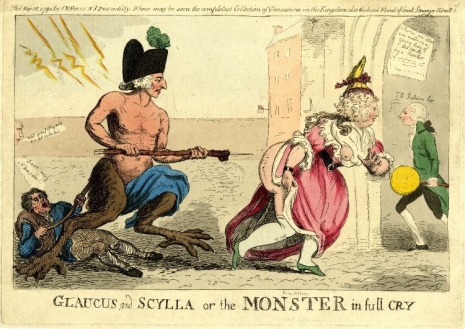
A bizarre illustration/caricature by James Gillray of the ‘Monster’ (aka the ‘Cutting Monster’) assaulting one of his female victims, 1790.
Nearly a century before Jack the Ripper terrorized the streets of London, a serial lady-stalker dubbed the “Monster” (or the “Cutting Monster”) would attack his first victim in May 1788. During a short walk in the early evening to a friend’s home, Mrs. Maria Smyth had the misfortune to cross paths with a man who, according to a vintage account of the incident, made a loud, lascivious request of Mrs. Smyth. Smyth picked up the pace of her evening stroll which in turn caused her harasser to increase his lurid taunting. By the time Smyth got to her friend’s doorstep the man lurched quickly with a knife and stabbed her in the breast and thigh—something that would become somewhat of a signature move for the Monster.
More than 50 similar attacks by the roving slasher would occur over the course of a three-year period in which the Monster would seemingly go out of his way to stab his victims in the same areas—the breast, buttocks or thigh—after verbally accosting them in the street when they were not in the company of a male companion or chaperone. The slash-happy assailant also incorporated the use of a bouquet of flowers to conceal a knife which he would use to stab his targets in the face when he was able to convince them to get close enough to the flowers to smell them. It’s also been theorized that whoever the “Monster” was. he enjoyed slashing up his victim’s clothing almost as much as plunging his knife into their flesh. As you might imagine the incidents were covered by the newspapers of the day and in 1790 a rather terrifying and wildly out-of-proportion caricature was done by Scottish artist Isaac Cruikshank (pictured at the top of this post) and was published by S.W. Forest, which was based on a first hand account by three women who were attacked by the Monster.
In the summer of 1790, florist—and frequent visitor to London’s many brothels—Rhynwick Williams was picked-up by the Bow Street Runners (who were essentially functioning as an early version of the police during the time) on suspicion of being the man behind the sexually-charged attacks. William’s not only insisted he was innocent but was able to bring forward numerous witnesses that would vouch for his whereabouts during the crimes. As the furor surrounding the assaults had reached epidemic levels around London the prosecution in the case decided that charging Williams’ with “destruction of property” would bring the longest sentence—a possible seven years per crime. The destruction of property in this case being the clothing the Monster had such an affinity for shredding up while attacking his female victims.
The charge didn’t stick and Williams was tried a second time four months later and convicted of “three counts of wounding” which sent him to chokey for six years. Though the attacks all but stopped once Willams was locked up, he would continue to profess his innocence (noted in the 2002 book The London Monster: A Sanguinary Tale by Jan Bondeson) in letters from jail where he would cite criminal cases that were similar to the ones he was accused of in an attempt to perpetuate the idea that the “Monster” was still “out there” and that the cops were even covering up crimes to save face. When he was finally released Willams apparently married a woman who wasn’t afraid of sharp objects and according to historians of the case no further references to “Rhynwick Williams” were ever recorded with the exception of one that strongly suggests Williams changed his name to “Henry” so he could avoid further association with the Monster.

A strange depiction of London’s the ‘Monster.’

The second panel from Cruikshank’s depiction of the ‘Monster’ featuring his victim outfitted with protective ‘copper bottom.’ And yes, ‘copper bottoms’ were a thing back in the 18th century though they were used by women to ‘enhance’ their appearance.

The ‘Monster’ (now with three heads) attacking a pair of ‘old maids,’ 1790.
More of the Monster after the jump…





